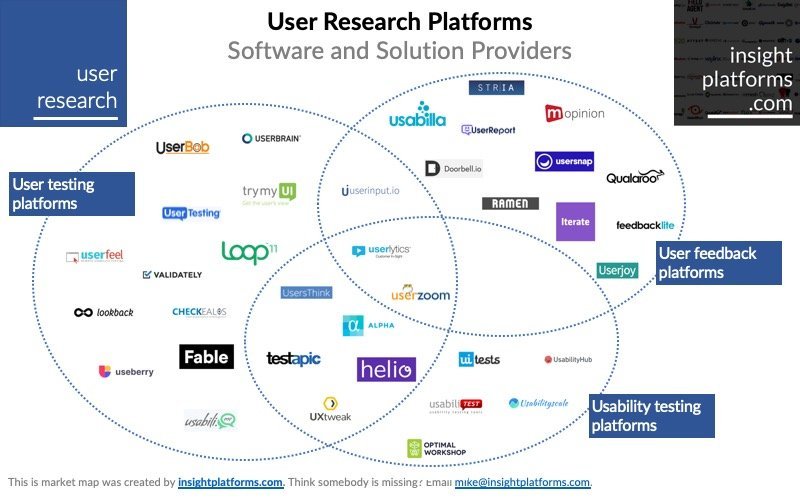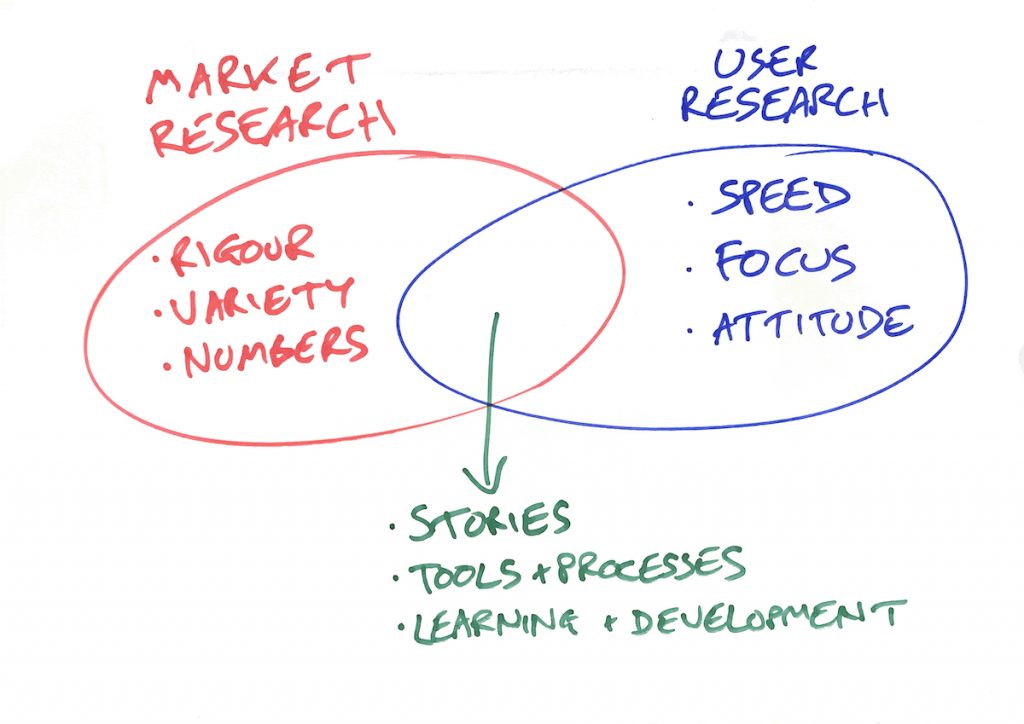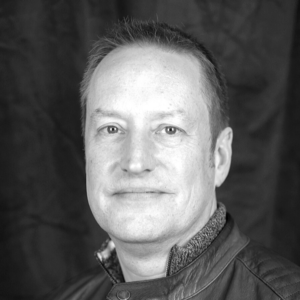This was the question debated by a handful of user research and market research experts at the IIEX Europe conference in Amsterdam last month.
I had the easy bit, asking questions. The trickier parts were handled by …
- Sarah Jousiffe, Head of Qualitative Research for Sky, the TV / telco media business now part of Comcast
- Youp van Veen, Design Researcher with Randstad, the HR consulting and recruitment firm
- Hélène van den Dries, UX Team Lead for WeTransfer, the online file-sharing company
- D’Arcy Rossiter, Founder of Red Isle Advisory and former Head of Insight for Hive, the home automation brand of energy firm British Gas.
Here we all are.

You know what I learned before this panel even started?
That this question is surprisingly sensitive and a little provocative. I spoke to more than a dozen heads of insight and user research about this panel. Several politely declined with various versions of “that’s a bit of a hot potato in our organisation”.
Who would have thought? Two tribes of researchers going to war.
But there was none of that animosity on stage. In fact, this lot got along well, and were quite aligned on most things.
(Which is also kind of a shame because we all love a good fight.)
So here’s an attempt to distill what we talked about and extract some learning.
What’s the difference between user research and market research anyway?
1. Positioning
You have to admit: user research just feels a bit cooler. It’s new and shiny. It’s grounded in design thinking and lean startup principles. It is mostly used to help develop software products and digital experiences – but is extending beyond that as well.
User research has also been far better at marketing itself. Just read all the posts about UX research on Medium.
Market research, on the other hand, has a colossal brand image problem.
They’re the people who do surveys and focus groups. They ask people which new toothpaste packaging they like best.
Read this article if you want to see how design research gets contrasted with market research (AKA badly run focus groups).
Then read the debate it kicked off on LinkedIn here (thanks Elina Halonen).
Market research has become a bit like Marks & Spencer.
I realise this may not mean much to readers outside the UK, but bear with me.
Think of a brand that trades on its history and has suffered decades of slow decline. It still has old, committed shoppers – but demography is taking care of them. And even though you might still go there for basics (underwear / surveys), the stuff you really want (nice food / strategic advice) is starting to look really pricey.
Tortured metaphor, sorry. I guess M&S can go on the ‘companies who will never hire me’ list now.
Anyway, bottom line: user research cool, market research a bit geography teacher.
2. Focus
Broadly speaking, user research is a qualitative discipline. It’s all about empathy, observation, probing, not forcing the answer to meet your brief.
There is some quantitative data – from page or app analytics – but as one of our panel members noted, “UX researchers are not so comfortable with numbers.“
Market research has a much more heterogeneous set of methods and tools. Social listening. Mystery shopping. Communities. Audience panels. Customer closeness programmes.
Apparently, some market researchers even use surveys and focus groups.
But this bigger toolbox also helps get some market research used for very big decisions.
“We miss the strategic view in the user research,” one of the panelists said.
“We had to make some market size estimates, and we were out of our depth … we needed to outsource the project to a market research agency.”
Bottom line: user research has clearer focus, but it’s more tactical; market research is a whole basket of hard-to-classify stuff, but it can be much more strategic.
3. Timescales
User research can be pretty hectic.
It’s normally focused on the specific task in hand: how to improve this feature, fix that bottleneck, increase conversion.
So it’s task-oriented, and often part of an agile process.
Timescales are measured in days or even hours:

But it’s also very iterative.
So it’s both short-term and a long-term.
The idea is to build broader insights from all these quick learnings.
Software like EnjoyHQ, Qualdesk, Sticktail and others are used to consolidate user research learnings over time.
Market research, on the other hand, has tended to see projects as separate entities.
And market research projects generally take longer and are often much bigger than user research projects.
I’m generalising, obviously.
Some insight community and agile testing tools deliver results in hours.
And the project mindset is shifting with better knowledge management tools.
Bottom line: user research is faster, with lots of small increments that build over time; market research has longer term, chunkier, more varied (and – historically – separate) projects.
4. Attitude
Carpe Diem. JFDI. Grab a user and start learning.
There’s an amazing culture to user research, and it’s really quite energising.
The philosophy – again, all very lean startup and design sprint – is that it’s more important to get feedback from users at the right time than it is to have a perfect world research design.
There are aspects to user research that are very guerilla. It’s a young, new discipline. It’s underpinned by enthusiasm and putting the user at the heart of everything.
And of course, this brings challenges, inefficiencies and – sometimes – a risk of digging up the wrong insights.
As one of our panel recalled, “Our product managers would turn left out of our office, park themselves in the nearest pub, and offer anyone there £15 to give feedback on the latest build of our app. Every so often, they would head out to the ATM and come back with fistfuls of notes to pay people.”
They might have been very chatty, but midday drinkers in central London weren’t exactly the bullseye persona for the app.
Market research, on the other hand, has become a bit more serious over the years.
It is done by in-house or agency experts. It has disciplines, standards, training courses and industry bodies. It uses recruitment screeners and professional interviewers.
It’s all a bit less chaotic. But it’s also slower, less democratised and more process-bound.
Yes, I know I’m exaggerating the differences.
User research has a lively and growing Research Ops community that is trying to rein in the chaos; and market research is getting more comfortable with lean process.
Bottom line: user research takes more of a ‘move fast and break things’ approach; market research folds its arms, shakes its head and says, ‘that’s how stuff gets broken.’
5. Structure
User research, as you’ve probably gathered, is more decentralised and embedded than market research. Designers, product managers, experience architects and even some developers will have a go.
And user research is more likely to be managed in-house than outsourced to agencies.
It is also better integrated into the systems and workflows of other teams.
What does that mean in practice?
If I’m a product manager building a prototype in InVision or Marvel, I can use the Maze integration to get instant user feedback from a panel of online testers.
If I’m a designer working on a web page in Sketch, I can get a quick proxy for eye-tracking research by using the Attention Insight integration. It gives me a heatmap that shows where users will spend time looking.
If I work in the analytics team, I can use fullstory or hotjar to capture screen recordings of users as they browse my site.
And there’s a very lively startup ecosystem for user research software.

But market research is still largely the preserve of experts with systems and tools that only they can use.
Yes, this is changing. Surveymonkey let everyone design a questionnaire, and enterprise tools like KnowledgeHound and Attest explicitly focus on helping non-researchers to do research.
But you don’t often see a brand manager moderating her own focus groups or a sales manager analysing survey results.
To be fair, until recently, you didn’t see many research managers doing this either. Market research has been outsourced to agencies. It’s only recently that it has started to come back in-house.
Bottom line: user research is done in-house by more people, many of whom are not actually researchers; market research tends to be managed by a specialist team with heavy support from agencies.
But surely user research and market research have things in common …
Of course they do.
In fact, the disciplines are steadily moving closer together.
User research is building more structure, discipline and standards.
Market research is getting faster, moving in-house, becoming more democratised.
Both are trying to build longer term insight capital with research and knowledge management tools.
In fact, some of the work we call ‘market research’ and ‘user research’ is practically identical. It just has different labels.
Qualitative depth interviews. Accompanied shops. In home observations. Customer closeness programmes. Narrated screen recordings.
So should these teams and disciplines just be mashed together?
What’s the worst that can happen?
Well, this is broadly where our panel netted out.
Don’t force it top-down
Let’s say I’m a CFO. I’ve got user research in my left hand and market research in my right. The differences seem arcane. I’m just going to fold them together and expect to save 30%.
I will be making a mistake. Potentially a pantomime horse of a department, with front and back ends that don’t really fit together.
This is not to say they can’t align – just that it’s a bad idea to force a top down combination for the sake of structural tidiness.
One of our panelists saw such an effort to bring user research and consumer insight into a single team.
It didn’t work – because of all the differences listed above – and it unwound quite quickly.
Bottom-up approaches to align rather than combine are much more likely to succeed.
Align stories
Insight into users (customers, consumers, members, whatevs) comes from all over the place. This makes it really easy to end up with conflicting stories.
User testing said this.
Yeah, but our tracking survey said that.
Well we don’t need your feedback because we have the DATA. It. Never. Lies.
You get the picture.
So the first big lesson that all our panel agreed on was the need to get stories straight between the different teams and data sources.
This isn’t just a user / market research thing. Analytics teams (BI, Data Science) need to be in the loop as well.
If you want a practical example of how this works, check out how Rufus Weston, Head of Insight for Just Eat, runs things in this interview:

Align tools and processes
User research is developing more structure and consistency, with the Research Ops movement at the vanguard.
At the same time, market research is trying to relax a little – do more in-house, be more guerrilla, get comfortable with good enough.
Somewhere in the middle where these two meet are common processes and software tools.
Processes for recruitment, incentives, privacy and compliance, documentation etc should be identical between the two fields.
And there are lots of software tools that define themselves by their target audience (user or market research) when in fact they can do a perfectly good job for both.
Remote interviewing tools. Video management software that houses interview recordings. Research workflow management platforms. Insight and knowledge management software for analysis.
In fact, elsewhere at the same conference, there were some great examples of ‘market research’ tech being used for user research applications: incling’s community of booking.com partners, Crowdtech’s embedding into agile development process with 1 hour concept testing.
Who said market research was slow?
Align learning and development
There are many areas of common ground between the two disciplines. Qualitative methods. Interviewing techniques. Design thinking frameworks. Behavioural biases.
These should be trained together in a coherent framework that emphasises the common ground – as well highlighting legitimate differences.
But it’s not just about training researchers from both camps.
It’s also about research teams training others in the organisation to do their own research with users and customers.
Research teams need to start acting more as enablers and less as project managers.
So what’s the answer?
OK, in a nutshell – this is it. Lots of people will get all shrill over this and hate me for it … but it’s intended to be respectful to both sides.

If you want to get more alignment between the two teams, don’t kill what makes each of them great and distinctive.
Respect market research’s rigour in sampling, design and analysis. Celebrate its ability to use multiple methods to try and find an answer. And let it take care of things with numbers, because user researchers aren’t really into spreadsheets and data tables.
Don’t slow down user research by smothering it in too much process. Let it stay laser-focused on the specific user or product challenge it needs to inform. And keep the attitude: some insight is better than none, today is better than tomorrow, just get some feedback.
But there are clear opportunities to bring these two closer together.
Sense check each others’ stories when research is done on the same topic or customer group. Find common ground with software tools that serve needs on both sides. And bring together training and best practice sharing wherever it makes sense.
User research and market research have a lot to offer one another.
Just don’t force them into the same box right now.

